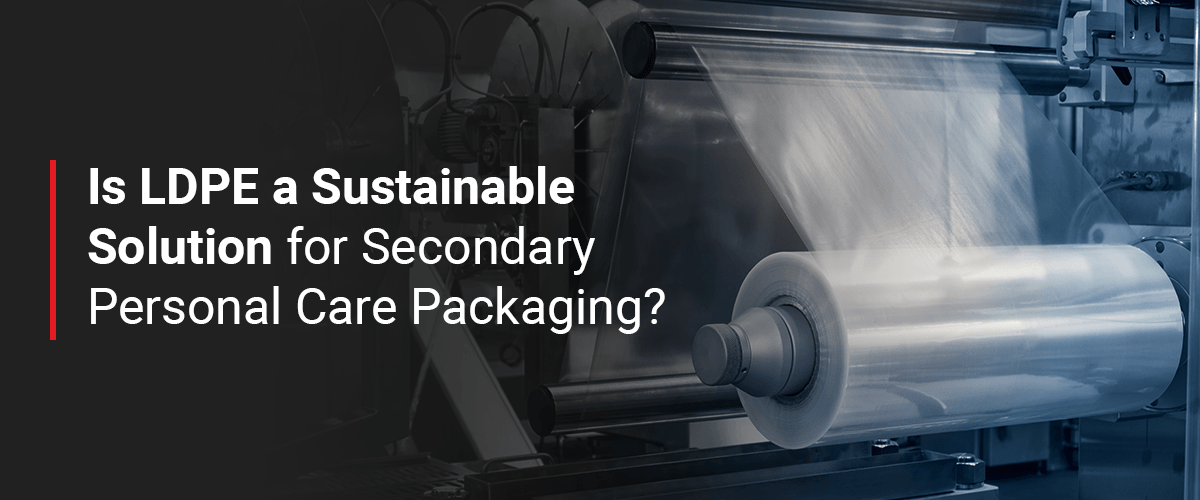20 January 2021 //
Sustainability has been a buzzword for years and is largely based on identifying the “best” solution long term. In secondary/tertiary packaging, the two most prominent options are rigid packaging, fiber-based products (i.e., chipboard and corrugate) and flexible packaging, resin-based options (i.e., LDPE films).
For producers and retailers of personal care products that require a smaller count distribution package, Low Density Polyethylene film (LDPE) can be the most sustainable way to package goods. In particular, LDPE for personal care packaging can help companies meet their financial and logistical goals as well as potentially pursue green initiative through improved recycling.
Lifecycle Costs
Compared to the life cycle of paper products, LDPE films and resins can be a much more efficient process when you look at it holistically. Chipboard and corrugate, which originates from trees or recycled paper, require a significant amount of energy and water to produce and recycle.
In contrast, LDPE is derived from ethylene gas (a product of natural gas) in a process called cracking. LDPE production requires a relatively low amount of energy. The process of using ethylene to create goods is not only considered a sustainable practice, but good for the U.S. economy given the vast amounts of this natural resource.
Transportation is another aspect of the cost of using chipboard and corrugated. The cost of transporting the packaging from the paper mill to the point of use is also higher than for LDPE since the former materials take up more space and have a higher weight. Whereas chipboard and corrugate are bulky, LDPE film is wrapped tightly in a roll, allowing for more efficient shipping. This characteristic enables shippers to increase pallet density and fit more products onto a single truck.
Recyclability
Another advantage of LDPE is its recyclability. As consumers and manufacturers are making every effort to limit the amount of matter placed into landfills, they are giving a hard look to the recyclability of packaging material and, in this case, secondary packaging.
This growing trend has been a boon for blown film manufacturers, as LDPE is the most sustainable secondary packaging material out there. Why? LDPE is a wonderfully easy product to recycle – so much so that the scrap material can be sold to recyclers. Some packaging companies will also recycle their LDPE material used in testing by compressing it before a local recycler washes the film, compacting it into a material suitable for use in post-consumer applications. This process helps eliminate LDPE from landfills.
Recycling LDPE film is also a relatively simple and low-cost activity for recyclers. All of the steps in the recycling process can be performed using technology in the U.S., saving money and energy for shipping the material overseas. First, plastic film is separated by density, color, and printing to maintain the value of the end product. The recycler then shreds and cleans the film before turning it into pellets, which can be combined with virgin LDPE or other recycled LDPE for various applications.
Recycled resins find their way into a number of everyday products ranging from carpet and clothing to playground equipment and poly deck boards. Recycled LDPE film applications include:
- Plastic piping and sheeting
- Films
- Trash bags and liners
Without the benefit of using post-consumer/post-industrial scrap, these products (and others) would be cost-prohibitive for consumers at large. By recycling LDPE, consumers and manufacturers reduce the costs of managing and removing waste and decrease their energy demands. The use and recycling of LDPE have a cascading positive effect on society.
LDPE Alignment With Personal Care Packaging Formats
Personal care product packaging comes in various formats, including bottles, tubes, and jars. All of these primary packaging solutions benefit from LDPE shrink-bundled secondary packaging. LDPE is an economical and sustainable means of unitizing multiple items to aid in retail distribution and shelving.
Packaging companies wrap the polyethylene (PE) material loosely around the unit of personal care items, then apply the right amount of heat to shrink the film tightly and conform to the product’s shape. This process can efficiently wrap multiple bottles or tubes together for easy shipping.
Several benefits of LDPE packaging make the process cost-effective and flexible enough to fit any product. The film comes in various thicknesses so companies can find the packaging solution that best suits their products. With options for printing on the film, companies can create professional-looking multipacks of their products. Strong, flexible LDPE film provides high-quality durability in any application while minimizing packaging and shipping costs. LDPE sometimes eliminates a shipper altogether, creating a sustainable secondary packaging option.
Contact EDL Packaging for Your LDPE Packaging Needs
Taken in total, LDPE films are largely overlooked as a sustainable packaging solution. However, when compared to conventional options in terms of lifecycle costs, recyclability and distribution, LDPE is truly the best solution for packaging personal care items.
Are you looking for a sustainable secondary packaging material solution? EDL Packaging offers flexible and customizable LDPE packaging solutions to fit your company’s needs. Our packaging machines provide you with efficient, cost-saving film packaging tailored to your products, so you can maximize your secondary packaging and shipping processes. Contact EDL Packaging today to learn how LDPE can provide significant advantages to your next project.

